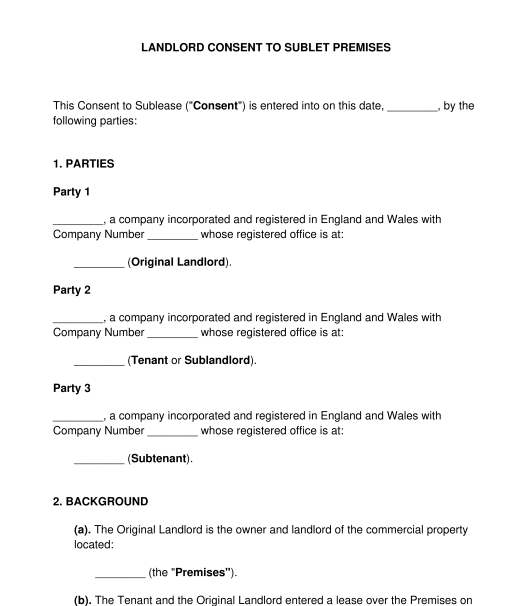 01/09/2025
01/09/2025

Answer a few questions and your document is created automatically.

Your document is ready! You will receive it in Word and PDF formats. You will be able to modify it.

 01/09/2025
01/09/2025
 Word and PDF
Word and PDF
 4 to 6 pages
4 to 6 pages
A Consent for Subleasing Commercial Premises is a formal agreement or document with which a landlord of a property grants their permission to the tenant to sublease the commercial property to another party (i.e. the subtenant).
Yes, it is mandatory to have a Consent for Subleasing of Commercial Premises. This is because most commercial leases require the tenant to get the landlord's written consent before they can sublease the property to another party. As such, a Consent for Subleasing of Commercial Premises satisfies this requirement and serves as concrete evidence that the landlord indeed agrees to the subleasing of the property. Additionally, the Consent for Subleasing of Commercial Premises clearly sets out the terms and conditions upon which the landlord agreed to the subleasing.
Before using a Consent for Subleasing of Commercial Premises, the tenant should first review the commercial lease to confirm whether subleasing is permitted and, if so, what conditions first need to be met before the premises can be subleased. Then, the tenant should send a formal request to the landlord asking for their consent to sublease the commercial property.
A Consent for Subleasing of Commercial Premises can be used by any landlord of a commercial property. The landlord can be a private individual or a business entity, such as a sole trader, a general partnership, an LLP or a company.
The commercial lease between the landlord and the tenant will usually state how long the landlord has to give their consent for the subleasing of the commercial property. Where the lease does not give a timeframe within which the landlord is to respond, the landlord should aim to respond within a reasonable time, which can be within 14 to 30 days. There is no obligation for the landlord to grant their consent for the commercial property to be subleased. This is because the decision to grant consent is up to the discretion of the landlord.
Once the Consent for Subleasing of Commercial Premises is completed, it should be signed by all the parties (i.e the landlord, the tenant and the subtenant). Each party should also be provided with a separate copy of the agreement to sign so that they can keep one for their records. The signed agreement can be attached to the commercial lease agreement or the sublease agreement.
The following documents can be attached to a Consent for Subleasing of Commercial Premises:
Yes, it is necessary to have witnesses for a Consent to Subleasing of Commercial Premises. This is because the agreement relates to a property transaction. Additionally, witnessing the signing serves as proof that no party was forced to sign it and that the parties understand what is contained in the agreement. A valid witness must be at least 18 years old and must not be a relative of any of the parties.
A Consent for Subleasing of Commercial Premises should contain:
Law of Property (Miscellaneous Provisions) Act 1994
You fill out a form. The document is created before your eyes as you respond to the questions.
At the end, you receive it in Word and PDF formats. You can modify it and reuse it.
Guides to help you
Country: United Kingdom